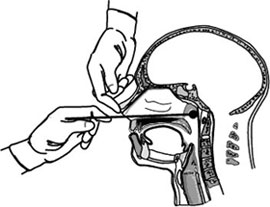การป้ายคอหอยส่วนจมูก
(เปลี่ยนทางจาก การกวาดคอหอยส่วนจมูก)
การป้ายสิ่งส่งตรวจจากคอหอยส่วนจมูก เป็นวิธีเก็บสิ่งส่งตรวจทางการแพทย์อย่างหนึ่ง ใช้เก็บสารคัดหลั่งโพรงจมูกจากส่วนคอหอยหลังโพรงจมูก สามารถนำสิ่งส่งตรวจที่เก็บได้จากวิธีนี้ไปตรวจหาสิ่งบ่งชี้โรคได้หลายอย่าง นิยมใช้ตรวจโรคไอกรน คอตีบ ไข้หวัดใหญ่ และโรคระบบทางเดินหายใจหลายโรค รวมไปถึง SARS, MERS และ COVID-19 ด้วย[1][2][3][4][5][6]
| Nasopharyngeal swab | |
|---|---|
| การวินิจฉัยทางการแพทย์ | |
 Nasopharyngeal swab | |
| เป้าหมาย | Diagnosis of certain viral infections |
| เม็ดไลน์พลัส | 003747 |
อ้างอิง แก้
- ↑ Junkins, A. (2010). "20. Identification of Pathogenic Bacteria". ใน Mukherjee, K.I.; Ghosh, S. (บ.ก.). Medical Laboratory Technology. Vol. 2 (2nd ed.). Tata McGraw-Hill. p. 515. ISBN 9781259000768.
- ↑ "Specimen Collection". Pertussis (Whooping Cough). Centers for Disease Control and Prevention. 18 November 2019. สืบค้นเมื่อ 25 March 2020.
- ↑ Irving, S.A.; Vandermause, M.F.; Shay, D.K.; Belongia, E.A. (2012). "Comparison of nasal and nasopharyngeal swabs for influenza detection in adults". Clinical Medicine & Research. 10 (4): 215–8. doi:10.3121/cmr.2012.1084. PMC 3494547. PMID 22723469.
{{cite journal}}: CS1 maint: multiple names: authors list (ลิงก์) - ↑ "Influenza Specimen Collection" (PDF). Centers for Disease Control and Prevention. n.d. สืบค้นเมื่อ 25 March 2020.
A nasopharyngeal (NP) swab is the optimal upper respiratory tract specimen collection method for influenza testing.
- ↑ McPherson, R.A.; Pincus, M.R. (2017). Henry's Clinical Diagnosis and Management by Laboratory Methods (First South Asia ed.). Elsevier. p. 1083. ISBN 9788131231272.
{{cite book}}: CS1 maint: multiple names: authors list (ลิงก์) - ↑ World Health Organization (19 March 2020). "Laboratory testing for coronavirus disease (COVID-19) in suspected human cases: Interim guidance, 19 March 2020". WHO/COVID-19/laboratory/2020.5. World Health Organization. สืบค้นเมื่อ 25 March 2020.